- Problematic Odors – Mushroom Composting
- Forced Aeration
- Ozonation for Odor Control
- GreenWood Mushroom Farm
- $10 Million lawsuit settled (press release)
- UBC Test Results
- Field Test Results
- UBC Odor Panel Verification
- Advances in System Design
- Increases in Contacting/Retention
- Ozone Demand
- Ozone System Improvements
1. Problematic Odors – Mushroom Composting
Studies of Phase I mushroom substrate odours have shown that composting odours may contain several types of malodorous chemicals. Included among these are reduced organic sulfur compounds (mercaptans and sulfides), amines and ammonia, volatile fatty acids, and compounds with less offensive odours such as alcohols and ketones (Miller et al., 1988; Derikx et al., 1990; Duns et al., 1997; Noble et al., 2001).
The reduced sulfur compounds are considered to be the most problematic of the above, due to their characteristically offensive odors combined with their low odour thresholds, although several compounds or classes of compounds may combine to produce offensive odours (Miller et al., 1988).
Several odour reduction measures have accordingly been investigated. These methods include simply altering the choice and/or quantity of raw materials that are suspect sources of odour, such as reducing the amount poultry manure (Miller and Macauley, 1989; Pecchia et al., 2001) or gypsum (Beyer et al., 2002) as possible sources of odorous reduced sulfur compounds. These alterations of formulation have met with varying degrees of success in reducing odour emissions, but the possible detrimental effects of such alterations on compost quality and mushroom yield are always a concern to the grower.

Semi-permeable coverings of compost piles, which purportedly retain odour compounds while allowing the release of ammonia and respiratory gases, have been investigated as a means for reducing odours (Beyer et al., 1997). The feasibility of biofilters for removing malodorous compounds from mushroom compost emissions has been demonstrated (Op den Camp et al., 1995). However, methods such as pile coverings and biofilters require periodic maintenance and adjustment, thereby becoming an investment of time and expense on behalf of the mushroom farm.
2. Forced Aeration
The use of forced aeration technology to aerate the compost in tunnels has become the most popular method for reducing mushroom substrate odour emissions. The compost in the bunkers or tunnels is periodically aerated by the forced passage of air through the compost from slatted floors or nozzles or spigots located on the floor of the bunker (Miller et al., 1990; Noble and Gaze, 1994). Several studies have indicated that forced aeration may have varying degrees of effectiveness in reducing mushroom substrate odour emissions (Noble et al., 2001, Perrin and Macauley, 1995; Duns et al., 2003).
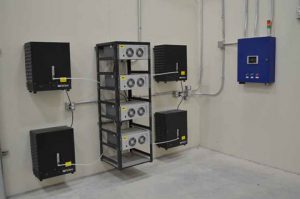
Reductions in the emission of odorous compounds in the range of 75-90% have been reported, although other studies have actually indicated an increase in the levels of odorous compounds in mushroom substrate treated by forced aeration (Op den Camp et al., 1995). Thus, additional and/or alternative and practical techniques for reducing odour emissions from mushroom substrate preparation are required.
3. Ozonation For Odor Control
Ozonation is one such alternate method for odour control. The principal of treatment of odours by ozonation involves the addition of Ozone (03) diluted in air to a ventilation system the evacuates the odourous compounds. Ozone is a powerful oxidant and a very reactive and unstable chemical. It is created by taking Oxygen from the air – O2 – and subjecting it to electrical (corona or plasma) and converting some of the Oxygen into Ozone or O3. Ozone treats odours by oxidizing odour compounds to form chemicals with less offensive odours or possibly no odour at all. At long contact or mixing times between ozone and odour compounds and with sufficiently high ozone dosage levels, the ultimate products of the ozonation of hydrocarbons are carbon dioxide and water, but in most cases the ozonation products are less odorous oxygenated chemicals (Nebel and Gottschling, 1975).
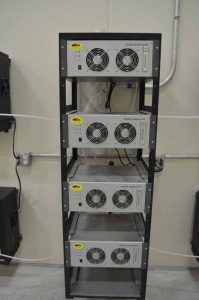
For example, the reaction between dimethyl sulfide, a known component of mushroom compost odour (Duns et al., 1997; Noble et al., 2001) and municipal composts (Day et al., 1998) results in the formation of inoffensive-smelling dimethyl sulfoxide and oxygen:
CH3-S- CH3 + 03 a– CH3 -SO- CH3 + 02
The use of ozone for the successful treatment of odours from various sources has been documented for some time. Ozonation odour treatment has been applied to many industries or processes, including rendering plants, fish processing plants, sewage treatment plants (Unangst and Nebel, 1971), rubber compounding plants and paint spraying facilities, as well as numerous other applications (Nebel and Gottschling, 1975).
Ozonation has also recently been applied to the treatment of odours from agricultural sources, such as swine production (Van Sickle, 1999; Kim-Yang et al., 2002).
Finney (1999) reported the successful removal of odours from traditional windrow mushroom composts from a mushroom farm in British Columbia as determined by an odour panel, using a temporary treatment facility. Ozonation also has an advantage as a method of odour treatment in that ozone can be generated on site from ambient air and thus requires only the initial investment of ozone generation equipment and a ventilation system to collect gases for treatment.
4. Greenwood Mushroom Farm
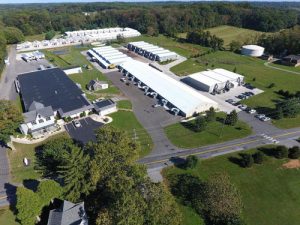
An ozone generating system was installed at Greenwood mushroom farm in Ontario in order to control the emission of odorous compounds during the Phase I preparation of mushroom substrate. This ozone system was custom designed and adapted to operate in conjunction with an existing forced aeration Phase I bunker facility. A ventilation system with manifold and ductwork was installed to direct the compost gases containing odour compounds into a reaction unit consisting of two mixing tanks connected in series. Ozone is produced by applying a corona discharge to oxygen concentrated from air and drawn into the reaction unit using a variable frequency fan, and mixed with the substrate gases. This system provides for an odour control system with facile operation and minimal maintenance. Chemical analysis was performed on samples of substrate gases collected in Tedlar bags taken before and after contact with the ozone. Reductions in odorous sulfur compounds of the gases in the range of 20-60% were obtained with the ozonation. Large variations in the sulfur compound content of both the pre- and post-treatment samples were observed, resulting in the observed range of reduction. The extent of the reduction appears to be dependent upon the operating conditions of the aerated bunker such as operation of the aeration fan, which generally results in increased input of odour compounds. Increasing the amount of ozone introduced into the system appears to increase the efficacy of the system for reducing sulfur compound levels.
5. Press Release Issued by Greenwood Mushroom Farm (2007)
FOR IMMEDIATE RELEASE:
On July 12, 2007, the Ontario Superior Court of Justice ordered the action brought against Greenwood Mushroom Farm by neighboring property owners dismissed, without costs. In July of 2004 150 plaintiffs filed a claim with the court seeking in excess of $10 million for damages as a result of nuisance, alleging that the odour emission discharged from the mushroom operation into the natural environment caused loss of use and enjoyment of the plaintiff’s property, affect the health of the plaintiffs and have an adverse effect on the natural environment.
The order by the Ontario Superior Court of Justice was the result of a motion made by the plaintiffs requesting the dismissal on consent of both parties. Neighboring property owners and the community agreed that the introduction and use of ozone to control the odour in the Phase I composting process had successfully alleviated their concerns.
Through a research project coordinated by the Canadian Mushroom Growers Association, an odour control system using ozone technology was successfully developed to mitigate the odorous exhaust associated with bunker composting on a commercial scale application. The project was funded by the Ontario Agricultural Commodity Council, Agricultural Adaptation Council and Greenwood Mushroom Farm. Engineering, design and technical support for the project was provided by Envron Environmental Ltd., and AirChem Consulting and Research Inc.
Envron Ozone System Development – History
6. UBC Test Results – Field Trial Mushroom Composting Odors
In conjunction with the University of British Columbia and the British Columbia
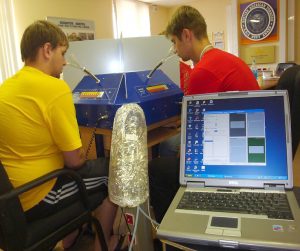
Ministry of Agriculture, testing of the Envron odor control system was conducted. A local mushroom composting facility was chosen as the test site and a compost stack was used to gather odorous off-gas. Ozone was then applied to the off-gas using an Envron mixing system. These gases were collected and tested using an odor panel (ENV13725).
The odor panel tests are double-blind experiments in which people are given measured odorous gases or non-odorous gases to sniff through a metering system. As the human nose is very sensitive (and also the ultimate test in odor control) the panel indicates whether people would find the odors offensive or not. The odors are then diluted by the machine to see at what levels it becomes non-offensive. As well, Envron used field test equipment to measure percentage gas reductions.
Breakdown of Odors by Ozone
Table 1. – Conversion of Organic Compounds By Ozone
COMPOUNDS CONVERTED TO
| Ammonia | To Nitrogen and Water Vapor |
| Ammonia Hydroxide | To CO2 and Water |
| Aromatic Compounds | To CO2 and Water Vapor and Oxygen |
| Aliphatic Compounds | To CO2 and Water Vapor and Oxygen |
| Cyanide | To Cyanate to Nitrogen and CO2 |
| Ferrous Iron | To Ferric Hydroxide |
| Formaldehyde | To Carbonic Acid-CO2 and Water |
| Formic Acid | To Carbon Dioxide and Water |
| Carbonic Acid | To Carbon Dioxide |
| Ethylene | To Carbon Dioxide and Water |
| Manganese | To Manganese Dioxide to Permanganate |
| Methane | To Carbon Dioxide and Water |
| Nitrite | To Nitrate |
| Organic Acids | To Carbon Dioxide, Water Vapor and Oxygen |
| Smoke | To Carbon Dioxide and Water |
| Sulphur Compounds (H2S) | To Carbon Dioxide, Water, Sulphur trioxide and Oxygen |
| Trichloroethylene | To Carbon Dioxide, Water, Hydrogen Chloride |
7. Field Test Results
After running the tests using the destruct stack, Envron’s field testing found an average decrease in total Amines after 48 seconds contact time of 21%. Because total amines represent “long-term” ozone demand, Amines are a good indicator that “instant” ozone demand has been satisfied. After 303 seconds an average decrease in total Amines of 59% was found. Everyone at the test site sniffed the gases coming out of the stack with Ozone applied and without Ozone applied. Without Ozone everyone agreed that the gases were odorous. With Ozone everyone agreed that the smell was gone.
8. Odor Panel Verification of Field Tests
The reductions in Amines indicated that within a number of seconds, there should have been a very high reduction in odorous (long-chain) compounds. After the tests came back from the UBC odor panel, the odor panel had confirmed the field tests. The untreated samples required dilution rates of between 1701-3043, which is typical of odorous substances. The Ozone treated samples were between 209-264, which is typical of non-odorous substances. As well, the treated samples had a faint Ozone smell, which is an almost antiseptic or sanitary smell.
These results are consistent with commercial use of Ozone odor control systems in other industries.
9. Advances in System Design and Ozone Technology
The Greenwood system resulted in a number of results that have been adapted to Envron’s latest systems:

- Increases in contacting and retention improves system performance
- The use of higher levels of ozone results in higher degradation of odorous compounds
- Maintenance and housing of the ozone generating system is emphasized
- System redundancy and trouble-free operation are key operating parameters
10. Increases in Contacting/Retention
The original system installed on the Greenwood bunkers allowed for several seconds of contacting/retention. As noted in the Duns report an increase in contacting/retention times will result in further degradation of odourous compounds greatly increasing efficiency. In subsequent odor control installations in slaughterhouses and other industries the use of much longer retention times has increased the efficiency of ozone being used for odor control in general.
11. Ozone Demand
There are two types of ozone demand in an odorous airstream – short-term or “instant” ozone demand and “long-term” ozone demand that would, given enough contacting and retention time, result in the following breakdowns of odorous substances.
The practicalities of achieving this level of odor control would result in contacting/retention systems that are simply too large to be practical. However, by increasing contacting/retention times while simultaneously increasing ozone dosages the level of odors can be significantly reduced surpassing the Greenwood results.
12. Ozone system improvements – Output and Maintenance
With the advancement of ozone generating systems – 5th generation systems
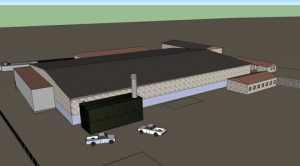
are now much more efficient, produce more ozone and require less maintenance. System maintenance can now be accomplished on-site by anyone with basic plumbing skills. In the past the complete breakdown of the ozone generator to component (Ozone generating tube) level was required to clean the tube. A simple water flush can now be used to clean the generating tube.
Because of the economics of ozone generators and the fact that the per gram cost of ozone has dropped significantly in the past years, ozone systems can be set up as a distributed system for odor control operations. This means that instead of a single ozone generator being used, two or more generators can be utilized to provide a level of system redundancy. Which means that removing a single generator for maintenance or repair will not result in a significant level of odor removal. In the older systems when the generator was removed for servicing or maintenance, odor control would not be available.
Contacting/retention system design has been improved with the use of sea containers as a contacting/retention vessel. This provides a very economical method of increasing retention times while adding minimal overall system costs.
